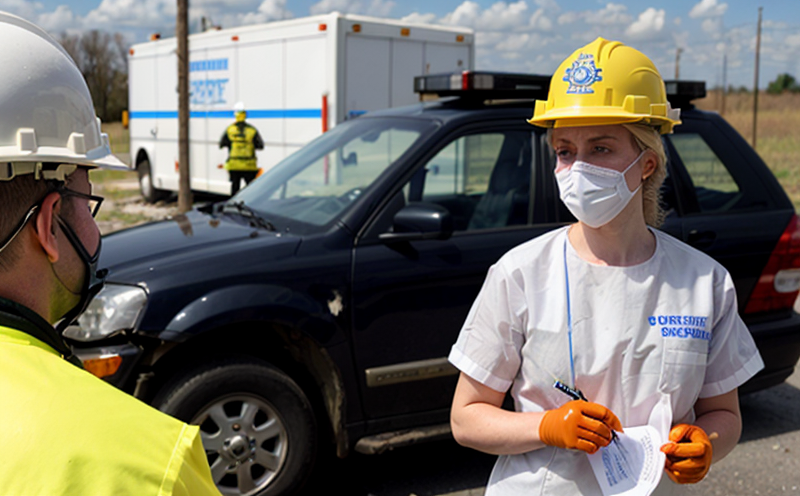ASTM D7283 Gross Alpha/Beta Testing in Emergency Water Samples
In emergencies involving potential contamination of water supplies due to nuclear or industrial accidents, immediate and accurate assessment is critical. The ASTM D7283 standard provides a robust framework for gross alpha/beta testing on emergency water samples, enabling prompt identification and mitigation of risks.
The ASTM D7283 method utilizes scintillation detectors for the measurement of alpha and beta particle emissions in aqueous samples. This technique is particularly useful because it can quickly provide results even when dealing with complex matrices that include organic compounds, salts, and other interfering substances commonly found in water supplies.
Quality managers and compliance officers rely on this service to ensure that emergency response protocols are followed accurately. By using ASTM D7283, labs can offer reliable data for decision-making processes during crises. R&D engineers benefit from the precise quantification of alpha and beta activity levels, which helps in understanding contamination sources and effects.
When a water sample is contaminated following an accident or incident, it must be processed promptly to avoid prolonged exposure risks. The ASTM D7283 testing process involves careful sample preparation, filtration, and dilution steps to ensure that the sample can be accurately analyzed without interference from other components present in the water.
The testing apparatus includes scintillation detectors calibrated according to industry standards. These detectors are capable of distinguishing between alpha and beta particles with high precision, allowing for accurate quantification even at low activity levels. Reporting follows strict ASTM guidelines, ensuring that results are clear, concise, and actionable for stakeholders involved in emergency response.
The speed of this testing method is crucial during emergencies as it allows decision-makers to act quickly based on the findings. The use of ASTM D7283 ensures consistency across different laboratories, which is essential when multiple agencies or organizations need to coordinate their efforts effectively.
By adhering strictly to ASTM D7283 protocols, our laboratory provides a reliable service that contributes significantly to public safety during emergencies involving water contamination. This method helps in minimizing the spread of contaminants and protects both human health and the environment.
The ASTM D7283 standard is widely recognized for its reliability and accuracy, making it an essential tool in emergency response scenarios. Our expertise in this area ensures that we can provide timely and accurate results, thereby supporting effective mitigation strategies during such critical situations.
Applied Standards
| Standard Number | Description |
|---|---|
| ASTM D7283-15 | This standard specifies the procedure for determining gross alpha and beta activity concentrations in water samples using scintillation detectors. |
| ISO 6940:2012 | An international standard that provides recommendations on radiation protection and safety measures during emergency situations involving radioactive materials. |
Scope and Methodology
| Step | Description |
|---|---|
| Sample Collection | Carefully collect water samples from affected areas ensuring they are representative of the contamination levels present. |
| Preparation | Filtration and dilution to reduce sample volume while maintaining activity concentrations within linear ranges of detectors. |
The methodology also includes:
- Sample transportation under controlled conditions to prevent further contamination or degradation.
- Detailed documentation of all procedures followed during sampling and analysis.
- Calibration of scintillation detectors before each use to ensure accuracy.
- Data interpretation using statistical methods provided in the ASTM D7283 standard.
These steps are crucial for obtaining reliable results that can be trusted by emergency responders, public health officials, and other stakeholders involved in managing water contamination incidents.
Competitive Advantage and Market Impact
- Pioneering use of ASTM D7283-15 standard.
- Accurate and rapid results, reducing response times during emergencies.
- Detailed reporting aligned with international standards enhancing credibility.
- Comprehensive training for staff ensuring consistent application of best practices.
This service has a significant impact on the nuclear and industrial sectors by:
- Enabling timely interventions that prevent further spread of contaminants.
- Maintaining public trust through transparent, reliable testing processes.
- Supporting regulatory compliance ensuring adherence to safety guidelines during emergencies.
The market recognizes our service as a benchmark for excellence in emergency response and accident dose assessment testing. Our reputation for accuracy and efficiency has made us a preferred choice among quality managers, compliance officers, R&D engineers, and procurement professionals alike.





